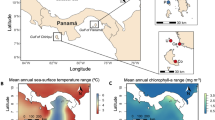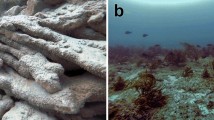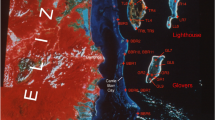Abstract
Climate change is now the leading cause of coral-reef degradation and is altering the adaptive landscape of coral populations1,2. Increasing sea temperatures and declining carbonate saturation states are inhibiting short-term rates of coral calcification, carbonate precipitation and submarine cementation3,4,5. A critical challenge to coral-reef conservation is understanding the mechanisms by which environmental perturbations scale up to influence long-term rates of reef-framework construction and ecosystem function6,7. Here we reconstruct climatic and oceanographic variability using corals sampled from a 6,750-year core from Pacific Panamá. Simultaneous reconstructions of coral palaeophysiology and reef accretion allowed us to identify the climatic and biotic thresholds associated with a 2,500-year hiatus in vertical accretion beginning ∼4,100 years ago8. Stronger upwelling, cooler sea temperatures and greater precipitation—indicators of La Niña-like conditions—were closely associated with abrupt reef shutdown. The physiological condition of the corals deteriorated at the onset of the hiatus, corroborating theoretical predictions that the tipping points of radical ecosystem transitions should be manifested sublethally in the biotic constituents9. Future climate change could cause similar threshold behaviours, leading to another shutdown in reef development in the tropical eastern Pacific.
This is a preview of subscription content, access via your institution
Access options
Subscribe to this journal
Receive 12 print issues and online access
$209.00 per year
only $17.42 per issue
Buy this article
- Purchase on Springer Link
- Instant access to full article PDF
Prices may be subject to local taxes which are calculated during checkout



Similar content being viewed by others
References
Donner, S. D. Coping with commitment: Projected thermal stress on coral reefs under different future scenarios. PLoS ONE 4, e5712 (2009).
Pandolfi, J. M., Connolly, S. R., Marshalland, D. J. & Cohen, A. L. Projecting coral reef futures under global warming and ocean acidification. Science 333, 418–422 (2011).
Manzello, D. P. et al. Poorly cemented coral reefs of the eastern tropical Pacific: Possible insights into reef development in a high-CO2 world. Proc. Natl Acad. Sci. USA 105, 10450–10455 (2008).
De’ath, G., Lough, J. M. & Fabricius, K. E. Declining coral calcificaton on the Great Barrier Reef. Science 323, 116–119 (2009).
Cantin, N. E., Cohen, A. L., Karnauskas, K. B., Tarrant, A. M. & McCorkle, D. C. Ocean warming slows coral growth in the central Red Sea. Science 329, 322–325 (2010).
Perry, C. T. et al. Caribbean-wide decline in carbonate production threatens coral reef growth. Nature Commun. 4, 1402 (2013).
Alvarez-Filip, L., Carricart-Ganivet, J. P., Horta-Puga, G. & Iglesias-Prieto, R. Shifts in coral-assemblage composition do not ensure persistence of reef functionality. Sci. Rep. 2, srep03486 (2013).
Toth, L. T. et al. ENSO drove 2500-year collapse of eastern Pacific coral reefs. Science 337, 81–84 (2012).
Scheffer, M. et al. Early-warning signals for critical transitions. Nature 461, 53–59 (2009).
Kiessling, W. Geologic and biologic controls on the evolution of reefs. Ann. Rev. Ecol. Evol. Syst. 40, 173–192 (2009).
Dixit, Y., Hodell, D. A. & Petrie, C. A. Abrupt weakening of the summer monsoon in northwest India ∼4100 yr ago. Geology 42, 339–342 (2014).
Liu, Z. et al. Paired oxygen isotope records reveal modern North American atmospheric dynamics during the Holocene. Nature Commun. 5, 3701 (2014).
Nurhati, I. S., Cobb, K. M. & DiLorenzo, E. Decadal-scale SST and salinity variations in the central Tropical Pacific: Signatures of natural and anthropogenic climate change. J. Clim. 24, 3294–3308 (2011).
Shen, G. T. et al. Surface ocean variability at Galapagos from 1936–1982: Calibration of geochemical tracers in corals. Paleoceanography 7, 563–588 (1992).
Grottoli, A. G. & Wellington, G. M. Effect of light and zooplankton on skeletal δ13C values in the eastern Pacific corals Pavona clavus and Pavona gigantea. Coral Reefs 18, 29–41 (1999).
Suzuki, A. et al. Skeletal isotope microprofiles of growth perturbations in Porites corals during the 1997–1998 mass bleaching event. Coral Reefs 22, 357–369 (2003).
Yu, J. & Elderfield., H. Benthic foraminiferal B/Ca ratios reflect deep water carbonate saturation state. Earth Planet. Sci. Lett. 258, 73–86 (2007).
Allison, N., Finch, A. A. & EIMF, δ11B, Sr, Mg and B in a modern Porites coral: The relationship between calcification site pH and skeletal chemistry. Geochim. Cosmochim. Acta 74, 1790–1800 (2010).
Koutavas, A. & Joanides, S. El Niño–Southern Oscillation extrema in the Holocene and Last Glacial Maximum. Paleoceanography 27, PA4208 (2012).
Pennington, J. T. et al. Primary production in the eastern tropical Pacific: A review. Prog. Oceanogr. 69, 285–317 (2006).
Conroy, J. L., Overpeck, J. T., Cole, J. E., Shanahan, T. M. & Steinitz-Kannan, M. Holocene changes in eastern tropical Pacific climate inferred from a Galápagos lake sediment record. Quat. Sci. Rev. 27, 1166–1180 (2008).
Glynn, P. W. Coral growth in upwelling and nonupwelling areas off the Pacific coast of Panama. J. Mar. Res. 35, 567–585 (1977).
Yan, H. et al. A record of the Southern Oscillation Index for the past 2,000 years from precipitation proxies. Nature Geosci. 4, 611–614 (2011).
Oppo, D. W., Rosenthal, Y. & Linsley, B. K. 2000-year-long temperature and hydrology reconstructions from the Indo-Pacific warm pool. Nature 460, 1113–1116 (2009).
Cobb, K. M., Charles, C. D., Cheng, H. & Edwards, R. L. El Niño/Southern Oscillation and tropical Pacific climate during the last millennium. Nature 424, 271–276 (2003).
Rein, B., Lückge, A. & Sirocko, F. A major Holocene ENSO anomaly during the Medieval period. Geophys. Res. Lett. 31, L17211 (2004).
Swart, P. K. et al. The 13C Suess effect in scleractinian corals mirror changes in the anthropogenic CO2 inventory of the surface oceans. Geophys. Res. Lett. 37, L05604 (2010).
Riding, R., Liang, L. & Braga, J. C. Millennial-scale ocean acidification and late Quaternary decline of cryptic bacterial crusts in tropical reefs. Geobiol. 12, 387–405 (2014).
McCulloch, M., Falter, J., Trotter, J. & Montagna, P. Coral resilience to ocean acidification and global warming through pH up-regulation. Nature Clim. Change 2, 623–627 (2012).
Acknowledgements
We are grateful to P. Swart, A. Rosenberg and A. Waite for providing assistance with geochemical analyses. We also thank M. Bush, P. Glynn, J. Trefry and R. van Woesik for advice and discussion. H. Guzmán and S. Dos Santos of the Smithsonian Tropical Research Institute provided regional temperature and rainfall data for the proxy calibrations. This research was financially supported by a Graduate Student Research Grant from the Geological Society of America, a grant from the Lerner–Gray Fund for Marine Research of the American Museum of Natural History, grants from the Smithsonian Institution’s Marine Science Network, and the Natural Science Foundation of China grant no. 41230524. Field work was carried out under permits from the Republic of Panamá. This paper is dedicated to the memory of G. M. Wellington, whose research in the eastern Pacific laid the foundations on which our work is built. This is Contribution 128 from the Institute for Research on Global Climate Change at the Florida Institute of Technology.
Author information
Authors and Affiliations
Contributions
L.T.T. conceived and designed the study, analysed the data, and wrote the paper. R.B.A. designed the study and wrote the paper. K.M.C. analysed the data and wrote the paper. H.C. and R.L.E. analysed the U-series data. P.R.G. and H.R.S. analysed the modern geochemical samples. All authors contributed to the discussion of results.
Corresponding author
Ethics declarations
Competing interests
The authors declare no competing financial interests.
Supplementary information
Rights and permissions
About this article
Cite this article
Toth, L., Aronson, R., Cobb, K. et al. Climatic and biotic thresholds of coral-reef shutdown. Nature Clim Change 5, 369–374 (2015). https://doi.org/10.1038/nclimate2541
Received:
Accepted:
Published:
Issue Date:
DOI: https://doi.org/10.1038/nclimate2541
This article is cited by
-
Upwelling, climate change, and the shifting geography of coral reef development
Scientific Reports (2023)
-
Changing Box–Cox transformation parameter as an early warning signal for abrupt climate change
Climate Dynamics (2023)
-
Climate and the latitudinal limits of subtropical reef development
Scientific Reports (2021)
-
Mutualistic microalgae co-diversify with reef corals that acquire symbionts during egg development
The ISME Journal (2021)
-
El Niño/Southern Oscillation during the 4.2 ka event recorded by growth rates of corals from the North South China Sea
Acta Oceanologica Sinica (2020)



